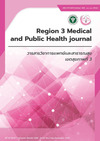ความเหมาะสมในการเตรียมเลือดสำหรับการผ่าตัดคลอดทางหน้าท้อง โรงพยาบาลอุทัยธานี
คำสำคัญ:
การเตรียมเลือดสำหรับการผ่าตัด, การผ่าตัดคลอดทางหน้าท้อง, ดัชนีความคุ้มค่าการใช้เลือดบทคัดย่อ
บทนำ: การเตรียมเลือดสำหรับการผ่าตัดที่มากเกินความจำเป็นและไม่สอดคล้องกับการใช้จริงของผู้ป่วย อาจส่งผลกระทบต่อระบบการสำรองเลือดของโรงพยาบาล เพิ่มภาระงานของเจ้าหน้าที่ธนาคารเลือดและสูญเสียค่าใช้จ่ายในการเตรียมเลือดเพิ่มขึ้น การผ่าตัดคลอดทางหน้าท้องเป็นหัตถการที่ทำมากเป็นอันดับต้นๆของโรงพยาบาลอุทัยธานี แต่ยังไม่มีการศึกษาถึงความเหมาะสมในการจองเลือดสำหรับการผ่าตัดคลอดทางหน้าท้องในโรงพยาบาลอุทัยธานีมาก่อน การศึกษานี้มีวัตถุประสงค์เพื่อศึกษาความเหมาะสมในการจองเลือดสำหรับผ่าตัดคลอดทางหน้าท้อง และศึกษาปัจจัยเสี่ยงที่มีผลต่อการได้รับเลือดในระหว่างผ่าตัดและภายใน 24 ชั่วโมง หลังผ่าตัดเพื่อนำผลการศึกษามาพัฒนาแนวทางในการเตรียมเลือดสำหรับการผ่าตัดคลอดทางหน้าท้องของโรงพยาบาลอุทัยธานีต่อไป
วิธีการศึกษา: เป็นการศึกษาเชิงพรรณนาแบบย้อนหลัง โดยเก็บรวบรวมข้อมูลจาก Anesthetic Record และเวชระเบียนของผู้ป่วยทุกรายที่เข้ารับการผ่าตัดคลอดทางหน้าท้องในโรงพยาบาลอุทัยธานีตั้งแต่วันที่ 1 ตุลาคม 2565 ถึงวันที่ 30 กันยายน 2566 เป็นระยะเวลา 1 ปี แล้วนำมาคำนวณความเหมาะสม ในการ เตรียมเลือดสำหรับผ่าตัดจากค่า Crossmatch to transfusion ratio (C/T ratio), Transfusion Probability (%T) และ Transfusion index (Ti) และวิเคราะห์ปัจจัยที่มีผลต่อการได้รับเลือดระหว่างผ่าตัดด้วย t-test, Chi-square test และ Binary Logistic Regression
ผลการศึกษา: จำนวนผู้ป่วยทั้งหมด 621 ราย พบว่าเป็น การเตรียมเลือดแบบ Type and screen 285 ราย (ร้อยละ 45.9) และเตรียมเลือดแบบ Crossmatch 336 ราย (ร้อยละ 54.1) จำนวนเลือดที่ Crossmatch ทั้งหมด 445 ยูนิต ใช้เลือดจริงจำนวน 48 ยูนิตสำหรับผู้ป่วย 33 ราย คำนวณ Crossmatch to transfusion ratio (C/T ratio) เท่ากับ 9.3, Transfusion Probability (%T) เท่ากับ 9.8 และ Transfusion index (Ti) เท่ากับ 0.14 การวิเคราะห์ปัจจัยที่มีผลกับการได้รับเลือดในระหว่างผ่าตัดและภายใน 24 ชั่วโมง หลังผ่าตัดพบว่า การมีภาวะโลหิตจาง (Hct<31%) ก่อนผ่าตัด (p-value<0.01, odds ratio 14.47, 95%CI 6.39-32.78) และภาวะรกเกาะต่ำ (Placenta previa) (p-value<0.01, odds ratio 1.82, 95%CI 1.37-2.41) มีผลต่อการได้รับเลือดอย่างมีนัยสำคัญทางสถิติ
สรุป: การเตรียมเลือดสำหรับการผ่าตัดคลอดทางหน้าท้องของโรงพยาบาลอุทัยธานีอยู่ในเกณฑ์ไม่เหมาะสม จึงควรใช้การ เตรียมเลือดแบบ Type and screen อย่างไรก็ตามควรพิจารณาปัจจัยด้านผู้ป่วยและความเสี่ยงในการเกิด Postpartum Hemorrhage มาประกอบกันเพื่อความปลอดภัยของผู้ป่วย
คำสำคัญ: การเตรียมเลือดสำหรับการผ่าตัด, การผ่าตัดคลอดทางหน้าท้อง, ดัชนีความคุ้มค่าการใช้เลือด
เอกสารอ้างอิง
Zewdie K, Genetu A, Mekonnen Y, Worku T, Sahlu A, Gulilalt D. Efficiency of blood utilization in elective surgical patients. BMC Health Serv Res 2019;19(1):804.
Woodrum CL, Wisniewski M, Triulzi DJ, Waters JH, Alarcon LH, Yazer MH. The effects of a data driven maximum surgical blood ordering schedule on preoperative blood ordering practices. Hematology 2017;22(9):571-577.
Haghpanah S, Miladi S, Kasraian L, Zamani A, Gholami M. Blood Transfusion Practice in Operating Rooms in Nemazee Hospital in Southern Iran. Arch Iran Med 2021;24(2):107-112.
Thabah R, Sailo LT, Bardoloi J, Lanleila M, Lyngdoh NM, Yunus M, Bhattacharyya P. Maximum surgical blood order schedule in a newly set-up tertiary care hospital. Anaesthesia, Pain and Intensive Care 2013;17:28-32.
Guduri PR, Shastry S, Raturi M, Shenoy A. Surgical blood ordering schedule for better inventory management: An experience from a tertiary care transfusion center. Med J Armed Forces India 2022;78:283-290.
Tiloklurs M, Klunklin G, Yimsabai J. Reduction the cost of blood preparation for transfusion in surgical patients by type and screen. Buddhachinraj Med J 2007;24:49-51.
พิมล เชี่ยวศิลป์,บรรณาธิการ. The Appropriate Use of Blood and Blood Components. พิมพ์ครั้งที่2. กรุงเทพมหานคร: สำนักพิมพ์ พิมพ์ณภัช; 2566.
Supakij Suwanrattanadech. Effectiveness index of routine crossmatch for elective caesarean section. Thai journal of anesthesiology 2020;46:149-53.
Ngamchuen Sripunlom, Sarwinee Ratchanon, Sirisuk Ouitrakul. Appropriateness of Routine Crossmatch in elective caesarean section for low risk postpartum hemorrhage pregnancies. Clinics in mother and child health 2018;15:1.
Trakulkasamsiri S. Cost reduction of crossmatching by type and screen protocol in Obstetrics patients at Queen Savang Vad-hana Memorial Hospital, Thai Red Cross Society. Bull Chiang Mai Assoc Med Sci 2007;40:114-117.
Chanachaisuwan P. Utilization in elective surgery at Police general hospital. Hematol Transfus Med J 2010;20:93-104.
Wilaiporn Chusri. An Approach to Blood Utilization in Elective Surgery at BMA General Hospital. J Hematol Transfus Med 2018;28:17-23.
Suwicha Limkitcharenporn. Blood Utilization and Influencing Factors of Postoperative Blood Transfusion for Patients Underwent Total Knee Arthroplasty in Damnoensaduak Hospital. Reg 4-5 Med J 2018 ;37:98-107
Iqbal K, Iqbal A, Rathore SS, Ahmed J, Ali SA, Farid E, Hasanain M, Azeem Q, Qadar LT, Memon FR, Azim D. Risk factors for blood transfusion in Cesarean section: A systematic review and meta-analysis. Transfus Clin Biol 2022;29:3-10.
OR Eyelade, OA Adesina, et al. Blood transfusion requirement during caesarean delivery: risk factors. Ann Ib Postgrad Med 2015;13:29-35.
Akinlusi FM, Rabiu KA, Durojaiye IA, Adewunmi AA, Ottun TA, Oshodi YA. Caesarean delivery-related blood transfusion: correlates in a tertiary hospital in Southwest Nigeria. BMC Pregnancy Childbirth 2018;18(1):24.
ดาวน์โหลด
เผยแพร่แล้ว
วิธีการอ้างอิง
ฉบับ
บท
การอนุญาต
ลิขสิทธิ์ (c) 2024 Region 3 Medical and Public Health Journal - วารสารวิชาการแพทย์และสาธารณสุข เขตสุขภาพที่ 3

This work is licensed under a Creative Commons Attribution-NonCommercial-NoDerivatives 4.0 International License.




